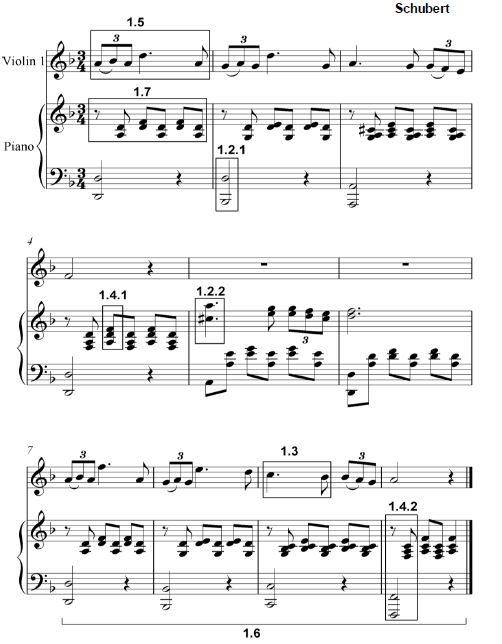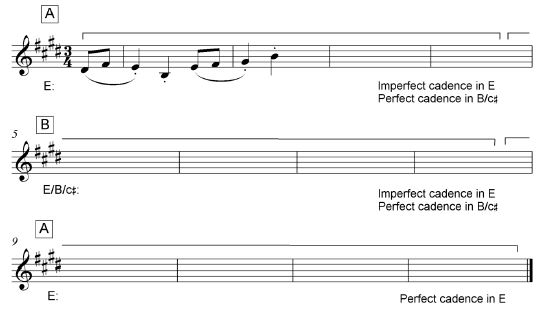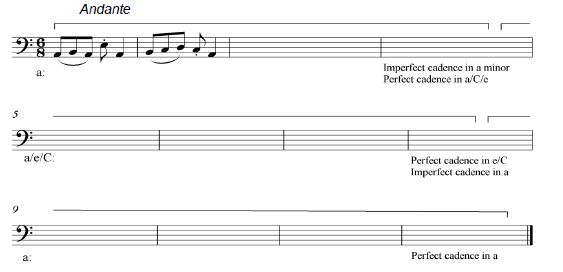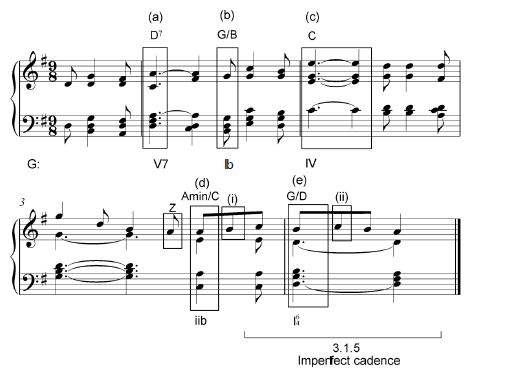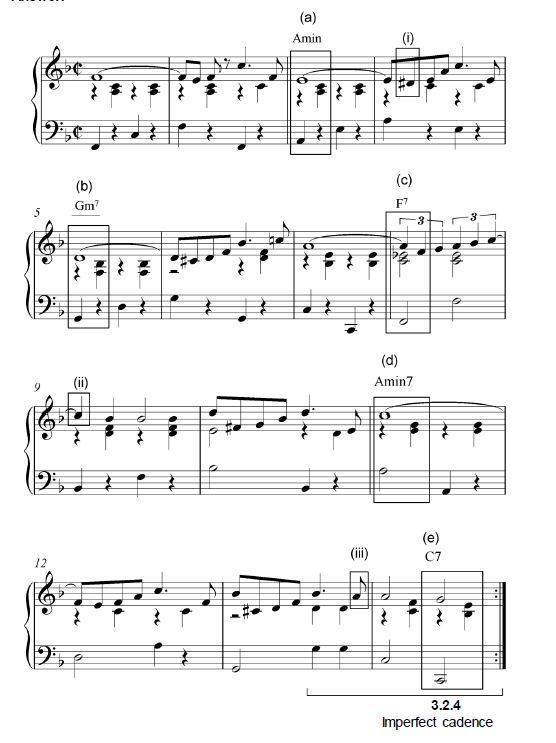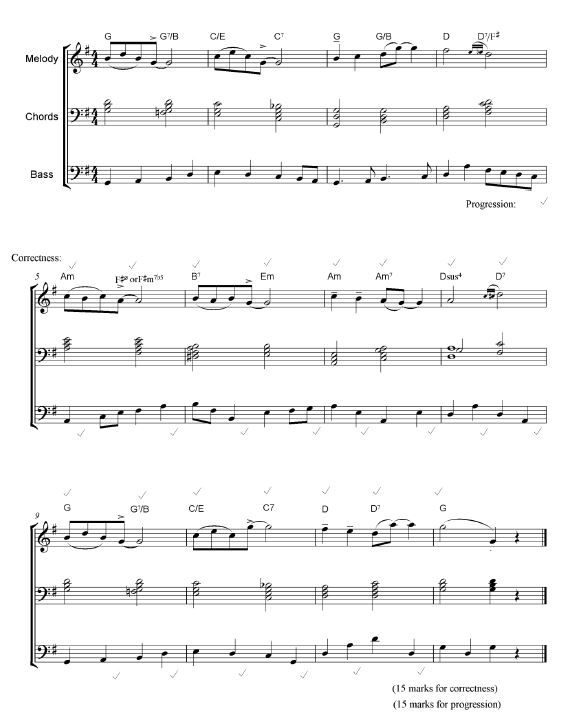MUSIC PAPER 1 GRADE 12 MEMORANDUM - NSC PAST PAPERS AND MEMOS FEBRUARY/MARCH 2017
Share via Whatsapp Join our WhatsApp Group Join our Telegram Group MUSIC
PAPER 1
GRADE 12
NSC PAST PAPERS AND MEMOS
FEBRUARY/MARCH 2017
INSTRUCTIONS AND INFORMATION
- This question paper consists of FIVE sections, namely SECTIONS A, B, C, D and E.
- SECTIONS A and B are COMPULSORY.
- SECTION C: WESTERN ART MUSIC (WAM), SECTION D: JAZZ and SECTION E: INDIGENOUS AFRICAN MUSIC (IAM) are choice questions. Answer only ONE of these sections (SECTION C or D or E).
- Write all music notation in SECTION A in pencil and all written text in blue or black ink on this question paper.
- Answer SECTION B and SECTION C or D or E in blue or black ink in the ANSWER BOOK provided.
- Number the answers correctly according to the numbering system used in this question paper.
- The last page of this question paper is manuscript paper intended for rough work. Candidates may remove this page.
- Candidates may NOT have access to any musical instrument for the duration of this examination.
- Candidates must take note of the mark allocation for each question to provide enough information in their answers.
- Write neatly and legibly.
MEMORANDUM
MARKING GRID
SECTION | QUESTION | MARKS | MARKER | MODERATOR |
A: THEORY OF MUSIC (COMPULSORY) | 1 | 20 | ||
2 | 15 | |||
3 | 10 | |||
4 | 15 | |||
SUBTOTAL | 60 | |||
AND | ||||
B: GENERAL (COMPULSORY) | 5 | 20 | ||
SUBTOTAL | 20 | |||
AND | ||||
C: WAM | 6 | 10 | ||
7 | 5 | |||
8 | 5 | |||
9 | 5 | |||
10 | 15 | |||
SUBTOTAL | 40 | |||
OR | ||||
D: JAZZ | 11 | 10 | ||
12 | 5 | |||
13 | 5 | |||
14 | 5 | |||
15 | 15 | |||
SUBTOTAL | 40 | |||
OR | ||||
E: IAM | 16 | 10 | ||
17 | 5 | |||
18 | 5 | |||
19 | 5 | |||
20 | 15 | |||
SUBTOTAL | 40 | |||
GRAND TOTAL | 120 | |||
SECTION A: THEORY OF MUSIC (COMPULSORY) (90 minutes)
Answer QUESTION 1
AND QUESTION 2.1 OR 2.2
AND QUESTION 3.1 OR 3.2
AND QUESTION 4.1 OR 4.2.
Answer the questions in the spaces provided on this question paper.
QUESTION 1 (25 minutes)
Study the extract below and answer the questions that follow.
Schuber
t
1.1 Name the main key of this piece.
Answer:
- D minor (1)
D minor = 1 mark |
1.2 Name the intervals at 1.2.1 and 1.2.2 according to type and distance. Answer:
1.2.1 Compound major 3rd/Major 10th
1.2.2 Minor 6th (2)
Compound major 3rd/Major 10th = 1 mark |
1.3 Write and name the inversion of the interval at 1.3.
Answer:
- Minor 7th (1)
Minor 7th= ½ mark |
1.4 Name the triads at 1.4.1 and 1.4.2 according to type and position/inversion.
Answer:
1.4.1 Minor – second inversion
1.4.2 Major – root position (2)
Minor = ½ mark |
1.5 Rewrite bar 1 of the violin part for viola using the same pitch.
½ ½ 
Clef = 1 mark |
1.6 Transpose the bass part from bars 7–10 a perfect fourth higher. Do NOT use a key signature.
Answer: 
Notation = ½ mark per bar = 2 marks |
1.7 Rewrite bar 1 of the right-hand part of the piano score in compound time. Add the new time signature.
Answer:
½ ½ 
Time signature = 1 mark Notation = 2 x ½ mark as indicated |
1.8 Write the scales below as indicated. Use semibreves.
1.8.1 Write F# melodic minor, ascending and descending, with key signature. Mark the semitones.
Answer: 
General assessment = 3 marks |
1.8.2 Write the Aeolian mode on E, descending in the alto clef.
Do NOT use a key signature.
Answer: 
Clef = 1 mark |
1.8.3 Write a chromatic scale on Bb, ascending only.
Answer:
(3)
General assessment = 3 marks |
[20]
QUESTION 2 (25 minutes)
Answer EITHER QUESTION 2.1 OR QUESTION 2.2.
2.1 Complete the opening motif below to form a twelve-bar melody in ternary form for any single-line melodic instrument of your choice. Name the instrument for which you are writing. Indicate the tempo and add dynamic and articulation marks.
Concept answer:
Instrument: Violin/Clarinet
Andante
OR
2.2
Concept answer:
Instrument: Cello/Trombone/Bassoon/Double Bass/Bass Guitar
Andante
The melody will be marked according to the following criteria:
DESCRIPTION | MARK ALLOCATION | ||
Form and cadential points | 1 mark per phrase x 3 | 3 | |
Correctness | Minus ½ mark per error up to 2 marks | 2 | |
Quality
| 9–10 | Excellent | 10 |
7–8 | Good | ||
4–6 | Average | ||
0–3 | Not acceptable | ||
TOTAL | Markers may use ½ marks | 15 | |
QUESTION 3 (10 minutes)
Answer EITHER QUESTION 3.1 OR QUESTION 3.2.
3.1 Study the extract by Mendelssohn below and answer the questions that follow.
Answer:
3.1.1 Name the key of this extract.
Answer:
- G major (1)
G major = 1 mark |
3.1.2 Identify the chords from (a)–(e) and figure them on the score. Use EITHER figuring below the score, for example V6, OR chord
symbols, for example C/E above the score.
Answer:
- See score (5)
1 mark per chord = 5 marks |
3.1.3 Name the types of non-chordal notes at (i) and (ii).
Answer:
- Passing note
- (Upper) Auxiliary (2)
(i) Passing note = 1 mark |
3.1.4 Which ONE of the following do you associate with the note at Z? Make a cross (X) in the appropriate block.
Anticipation | Suspension | Appoggiatura | Chord note |
Answer:(1)
Anticipation = 1 mark |
3.1.5 Name the cadence with which this extract ends.
Answer:
- Imperfect (cadence) (1)
Imperfect cadence = 1 mark (No marks if only chords are given) |
[10]
OR
3.2 Study the extract from Till by Charles Danvers below and answer the questions that follow.
Answer:
3.2.4 Imperfect cadence
3.2.1 Name the key of this extract.
Answer:
- F major (1)
F major = 1 mark |
3.2.2 Identify the chords from (a) to (e) and figure them on the score. Use chord symbols above the score, for example Bb/D
Answer:
- See score (5)
1 mark per chord = 5 marks |
3.2.3 Name the type of non-chordal notes at (i)–(iii).
Answer:
- (Chromatic lower) Auxiliary
- Suspension
- Anticipation (3)
(i) (Chromatic lower) Auxiliary = 1 mark |
3.2.4 Name the cadence at the end of this extract.
Answer:
- Imperfect (cadence) (1)
Imperfect = 1 mark |
[10]
QUESTION 4 (30 minutes)
Answer EITHER QUESTION 4.1 OR QUESTION 4.2.
4.1 Complete the four-part vocal harmonisation below by adding the alto, tenor and bass parts.
Concept answer:
The harmonisation will be marked according to the following criteria:
DESCRIPTION | MARK ALLOCATION | CANDIDATE'S MARKS | |
Chord progression | 1 mark between each pair of chords (except between bar 5 and 6) | 14 | |
Correctness | Minus ½ mark per error but not more than 1 mark per chord | 16 | |
Quality |
| 10 | |
Note to marker: | 40 (÷ 8 x 3) | ||
TOTAL | 15 | ||
Candidates must be credited for an alternative and correct harmonisation not given in the memorandum. The figuring serves as a guide for the marker, but no marks are allocated for the symbols as such.
[15]
OR
4.2 Complete the piece below by adding a suitable bass line and harmonic material in the open staves. Continue in the style suggested by the given material in bars 1–4.
Concept answer:
The harmonisation will be marked according to the following criteria:
DESCRIPTION | MARK ALLOCATION | CANDIDATE'S MARKS | |
Chord progression | 1 mark between each pair of chords | 15 | |
Correctness | Minus ½ mark per error but not more than 1 mark per chord | 15 | |
Quality |
| 10 | |
Note to marker: | 40 (÷ 8 x 3) | ||
TOTAL | 15 | ||
Candidates must be credited for an alternative and correct harmonisation not given in the memorandum. The figuring serves as a guide for the marker, but no marks are allocated for the symbols as such.
TOTAL SECTION A: 60
SECTIONS B, C, D, E: GENERAL MUSIC KNOWLEDGE (90 minutes)
Answer SECTION B
AND SECTION C (Western Art Music)
OR SECTION D (Jazz)
OR SECTION E (Indigenous African Music).
Candidates must answer these questions in the ANSWER BOOK provided.
Note to the marker: One mark will be allocated for each correct fact. Candidates must be credited for any correct answer not given in this memorandum. |
SECTION B: GENERAL (COMPULSORY)
QUESTION 5
5.1
5.1.1 B
5.1.2 D
5.1.3 B
5.1.4 C
5.1.5 A
5.1.6 C
5.1.7 D
5.1.8 B
5.1.9 C
5.1.10 A (10)
1 mark for each correct answer = 10 marks |
5.2
5.2.1 Monophony
5.2.2 Homophony
5.2.3 Polyphony
5.2.4 Ostinato
5.2.5 Modes
5.2.6 Tone colour/Timbre
5.2.7 A Cappella
5.2.8 Mediant (5)
Any 5 correct answers = 5 marks |
If candidate answers more than 5 questions, mark ONLY THE FIRST 5 answers |
5.3
- Divided into two sections/AB
- Section A usually starts in the tonic key
- Modulates to the dominant (or to the relative major if tonic was a minor key)
- Section B starts in the new key and modulates back to the tonic
- Both sections contain repeat signs
- The music material is similar in both sections
- Phrases are usually symmetrical (5)
Any 5 correct facts = 5 marks |
TOTAL SECTION B: 20
Answer SECTION C (WAM)
OR SECTION D (JAZZ)
OR SECTION E (IAM).
SECTION C: WESTERN ART MUSIC (WAM)
QUESTION 6
Note to the marker: One mark will be allocated for each correct fact. Candidates must be credited for any correct answer not given in this memorandum. |
6.1
6.1.1 Pamina/Papagena
6.1.2 Tamino
6.1.3 Monostatos/Papageno
6.1.4 Sarastro
6.1.5 Queen of the Night (5)
Each correct answer = 1 mark |
6.2
- Has a German text throughout
- Includes a spoken dialogue
- Arias are often simply strophic or folk-like (Papageno's song)
- The plot contains
- Comical elements (Papageno)
- Romantic elements (Tamino and Pamina)
- Fairytale elements (Rescue of a Princess)
- Magical and fantasy elements (Magic flute/Magic bells)
- Characterisations of good and evil (Sarastro/Queen of the Night) (5) [10]
Any 5 correct facts = 5 marks |
QUESTION 7
7.1 Development (1)
Correct answer = 1 mark |
7.2 To facilitate the modulation from Theme 1 to Theme 2.
(Major tonic to dominant/Minor tonic to relative major) (1)
Correct answer = 1 mark |
7.3
- The music modulates to various keys
- Music material from the exposition is varied using different compositional devices
- New material may be included (2)
Any 2 correct answers = 2 marks |
7.4
- Both Themes of the Recapitulation are in the tonic key
- Exposition ends with codetta in dominant key and Recapitulation ends with Coda in tonic key (1) [5]
Any correct answer = 1 mark |
QUESTION 8
Title given by Beethoven to describe the programmatic content.
Hirtengesang. Frohe, dankbare Gefühle nach dem Sturm,
or
Shepherds' song. Feelings of joy and gratitude after the Storm,
or
Herderslied, Vrolike en dankbare gevoelens na die Storm
Any one answer = 1 mark |
Programmatic content realised through music:
- a portrayal of calmness, a general feeling of relief after the storm
- brings us back to the pastoral nature of the first movement
- pastoral mood created by yodelling figure/a shepherd's pipe is heard on clarinet; this is answered by another (horn), and then another call (violin)
- starts with a gentle, lyric theme followed by more vigorous sections
Tempo: Allegretto – reinforces pastoral association
Key: F major – tonic key of work helps to establish the return of pastoral mood
Harmony: Simple harmony/tonal stability to set a relaxed, easy-going atmosphere
Time signature: 6/8 – lilting, relaxed mood [5]
Any 4 correct facts = 4 marks |
QUESTION 9
Definition: orchestral work usually in four movements
Orchestral work = ½ mark |
Explanation of differences:
Classical Symphony | Beethoven: Pastoral Symphony |
Four movements | Five movements |
Standard Classical orchestra | Standard Classical orchestra with additional piccolo and trombone |
Modulation to relative keys | Modulation to relative keys and modulation to distantly related keys |
Absolute music | Programmatic |
No titles | Titles for each movement |
Classical forms: e.g. sonata form, sonata rondo | Fourth movement is in episodic/free form |
More limited range of tone colour | Expanded range of tone colour |
Coda not developed | Coda expanded Almost a new development |
Fourth movement: mostly in rondo or sonata or sonata-rondo form, in the tonic key and has a fast tempo | Fourth movement in episodical/free form |
[5]
Any 4 correctly correlated facts = 4 marks |
QUESTION 10
Classical Features
Form and structure:
- Uses Sonata form
Tone Colour/Instrumentation:
- Standard classical orchestra
Melodic Material:
- Motivic development
- Clearly defined melodies
Harmony:
- Modulations to relative keys
- Strongly influenced by Mozart and Beethoven
- Use of tonal/classical harmony
Texture:
- Mainly homophonic with some polyphonic texture
Any 6 correct facts = 6 marks |
Romantic Features
Form and structure:
- Uses Sonata form but more free and varied e.g. unusual long codetta after the second subject in the exposition
Programmatic:
- Use of descriptive title and subtitle
- Romanticism brought through a new focus on nature
- Suggests a whole seascape, the grandeur of the cave, the swelling of the sea, the light on the water, the fury of the waves breaking on the cliffs
- One of the first Romantic compositions to suggest nature in this way
New genre:
- Concert Overture (foreshadowing the Tone Poem to come)
Dynamics:
- Very wide range from pp to ff
- Tempo and Rhythm:
- Extensive use of rubato
Melody:
- Lyrical melodies with an individual melodic style (especially in the second subject)
Harmony:
- Some use of chromatic harmony
Any 6 correct facts = 6 marks |
CRITERIA | MARK ALLOCATION | ||
Classical features | 1 mark for each correct fact | 6 | |
Romantic features | 1 mark for each correct fact | 6 | |
Logical presentation and structure | Excellent | = 3 marks | 3 |
Good | = 2 marks | ||
Average | = 1½ marks | ||
Below average | = 1 mark | ||
Weak | = ½ mark | ||
Not acceptable | = 0 marks | ||
TOTAL | 15 | ||
[15]
TOTAL SECTION C: 40
OR
SECTION D: JAZZ
QUESTION 11
11.1
- Contrapuntal melodies and weaving of different melody lines together
- Melody developed through improvisation
- Solo pennywhistle (or saxophone) plays melody
- Moderate to upbeat tempo
- Skiffle-like beat
- Jive/Swing rhythms (3)
Any 3 correct facts = 3 marks |
11.2
- Electric guitar
- Bass guitar
- Drums
- Keyboard/Organ (3)
Any 3 correct answers = 3 marks |
11.3
11.3.1Meadowlands
11.3.2 Pata Pata or Lakutshon'ilanga
11.3.3 Sakhile or Isililo
11.3.4 Khoedi (The Moon) (4)
Any four correct answers = 4 marks |
[10]
QUESTION 12
12.1 | TRUE |
12.2 | TRUE |
12.3 | FALSE |
12.4 | FALSE |
12.5 | TRUE |
[5]
5 correct answers = 5 marks |
QUESTION 13
International:
- Combined and blended different styles
- Jazz
- Blues
- R&B
- Contemporary folk
- Gospel
- English ballads
- Portuguese fados
- Yiddish folk melodies
- Commercial popular music
- Recordings of American jazz artists, e.g. Ella Fitzgerald
Local:
- Traditional songs of the Xhosa and Zulu languages
- Explosive, clicking sounds of her mother tongue: isiXhosa
- Uses a cappella healing chants of the Amasangoma
Vocal quality:
- Rich, low female voice often compared in quality to Ella Fitzgerald's [5]
Any 2 correct international,2 local and 1 quality fact = 5 marks |
QUESTION 14
- South Africa's first important bebop band in the 1950s
- Band consisted of South African jazz-icons (Dollar Brand (later Abdullah Ibrahim) on piano, Kippie Moeketsi on alto saxophone, Jonas Gwangwa on trombone, Hugh Masekela on trumpet, Johnny Gertze on bass, Early Mabuza or Makaya Ntshoko on drums)
- Started a particularly South African sound which individual artists developed over the following decades
- 1959: First album by a black South African band, Jazz Epistle, Verse 1
- 1959: The musicians were involved in the popular South African jazz musical, King Kong which toured overseas
- Many of these musicians chose exile and developed their style further through contact with European musicians. They ploughed back their new-found knowledge and skills into the South African context on their return [5]
Any 5 correct facts = 5 marks |
QUESTION 15
Origins
- Started: 1920 in Johannesburg (Sophiatown)
- Ticky-draai (Cape folk dance)
- Xhosa folk songs
- Early American jazz
- Ragtime
- Blues music (12 bar blues)
- Music at parties of urban working class African musicians
- Used for social occasions, e.g. stokvel parties
- Music used at shebeens for entertainment
Any 5 facts for 5 marks |
Characteristics
- Primarily a keyboard style
- Other characteristic instruments include: simple pedal organ, guitar, banjo, drum (self-made), percussion, e.g. shakers
- Small instrumental ensemble
- Cyclic chord progression: I – IV ––164 ––V
- Rearranged traditional melodies in a three-chord pattern
- Moderate to upbeat tempo and rhythm
- Repetitive, single-themed dance tunes
Any 5 facts for 5 marks |
Any artist and song
- Jazz Maniacs: Gully Low Blues
- The Manhattan Brothers: Jikela Emaweni
- The Flying Jazz Queens: Langa More
Any 1 artist and 1 song = 2 marks |
The essay will be marked according to the following criteria:
CRITERIA | MARK ALLOCATION | ||
Origins | 1 mark for each correct fact | 5 | |
Characteristics | 1 mark for each correct fact | 5 | |
Artist and song | 1 mark for each correct fact | 2 | |
Logical presentation and structure of the essay | Excellent | = 3 marks | 3 |
Good | = 2 marks | ||
Average | = 1½ marks | ||
Below average | = 1 mark | ||
Weak | = ½ mark | ||
Not acceptable | = 0 marks | ||
TOTAL | 15 | ||
[15]
TOTAL SECTION D: 40
OR
SECTION E: INDIGENOUS AFRICAN MUSIC (IAM)
QUESTION 16
16.1
16.1.1 False - with Paul Simon (1)
16.1.2 False - Malombo/Philip Tabane/Malombo Jazzmen (1)
16.1.3 False - Mbaqanga (1)
16.1.4 False - Marabi (1)
16.2
- A style of music that fuses Bapedi and Vhavenda music with jazz
- African rhythms provided by the malombo and bongo drums
- An interplay between drums, guitar and flute (2)
Any 2 correct facts = 2 marks |
16.3
16.3.1
- Ikati: plectrum used for guitar playing
- Ikati produces a percussive sound typical of the style
- Ukuvamba refers to strumming of chords percussively with plectrum
16.3.2
- Ukupika: picking of guitar strings with fingers
- Amadoda (thumb) plays the lower strings
- Amantombazane (rest of the fingers) play the melody on the upper strings (4)
2 correct facts for each = 4 marks |
[10]
QUESTION 17
- A modern version/construct of the Bapedi music/dance kiba
- Uses modern instruments instead of traditional Bapedi instruments
- Uses any African language in addition to Sepedi
- Not exclusive to any cultural group
- Performed over a standard contemporary drumbeat style (e.g. disco, jazz)
- Merges drum melo-rhythms with pluro-vocal responses, crepitations and vocal lilting
- The following traditional drums are used: Ditinti; Moropa wa diatla/Moropa; Kiba [5]
Any 5 correct facts = 5 marks |
QUESTION 18
AmaZulu: Amahubo
Ceremonial features/functions:
- Channel communication between the ancestors and community
- Used to please the ancestors
- Serves to strengthen identity of the clan
- Only performed by elders of a clan
- Only wives who have passed menopause are allowed at the performance
- Performed at important rituals e.g. preparing for war
Any 2 correct facts = 2 marks |
Role of dance, music and instruments:
- Amahubo are clan anthems (sacred songs)
- Overlapping call and response is characteristic of the music
- Leading part is usually a solo voice and response is done by the chorus
- Listeners participate in the amahubo with emotional responses evoked by the performer
- Each clan has its own Ihubo
- Use of body percussion
Any 3 correct facts = 3 marks 2 + 3 = 5 marks |
[5]
OR
AmaSwati: Inkwahla
Ceremonial features/functions:
- First fruits celebration
- The Inkwahla songs are reserved only for the Inkwahla ceremony and the death of a king
- It is a sacred celebration that reinforces the king's role in the Swazi nation
- Core function is to spiritually cleanse the King and his nation before they eat newly harvested crops
- In the opening of the ceremony, the community chants the Inkwahla songs, standing in a formation of a crescent moon
- Lyrics of the songs are usually mournful and moving
- In the second phase, young unmarried men gather at the king's home to create an enclosure with branches from a sacred tree, Lusekwane
- During the closing ceremony, the community gathers in full moon formation and chants the Inkwahla with great solemnity
Any 2 correct facts = 2 marks |
Role of dance, music and instruments:
- On the first day priests go into the sea, singing and dancing Inkwahla songs/dances, as they fill calabashes with water that will be used to cleanse the king
- On their return they sing the king's praises (Izibongo)
- On the second day young men sing a lullaby as they cut the Lusekwane branches to prepare for the king's re-birth
- During the ceremony warriors hold their shields and women hold thin long wands, waving them in time to the rhythm of the Inkwahla song
- Young unmarried men beat their shields against their sides in a steady rhythm likened to a mother rocking her baby
- The Umgubo, which is regarded as the national anthem, is performed to praise the king and end the day's activities
- Use of voice and body percussion, also includes shields and sticks
Any 3 correct facts = 3 marks 2 + 3 = 5 marks |
[5]
OR
AmaXhosa: Intonjane
Ceremonial features/functions:
- Seclusion period during female initiation
- One main song/dance is performed - Umngqungqo
- The Umngqungqo is performed by married women
- The song/dance is performed outdoors
- The women hold sticks in their right hands while dancing to imitate the men
- Umngqungqo music/dance lasts for 2 days
- Thereafter the men perform the Umdudo dance which lasts up to six days
Any 2 correct facts = 2 marks |
Role of dance, music and instruments:
- Two main dance movements, both characterised by walking, swaying and balancing on the ball of the foot then stomping the heel down are performed in a circle
- In the first movement they move clockwise, then change direction
- In the second movement they face inwards
- Dancers move with grace, shaking their shoulders
- Vocal parts are largely improvised
- There are no instruments, only the clapping of hands
- The Umdudo dance opens with the singing of Umyeyezelo and the beating of the Ingqongqo drum
Any 3 correct facts = 3 marks 2 + 3 = 5 marks |
[5]
OR
AmaNdebele: Luma
Ceremonial features/functions:
- First fruits celebration
- The community gathers at the king's home in February to celebrate the Ndebele heritage and welcome in the new year
- It is believed that the performance enables people to cast spells
- The performance of the song is strictly forbidden during any other time except the Luma celebration
- The Luma is believed to bring a sense of well-being in the nation
Any 2 correct facts = 2 marks |
Role of dance, music and instruments:
- Song/Dance used to rejoice and praise the king
- A special royal praise-song is performed (Luma song)
- The song is believed to bring rain
- The Luma song/dance is used to pray for fertility for crops
- Use of voice, dance and body percussion
Any 3 correct facts = 3 marks 2 + 3 = 5 marks |
[5]
OR
Basotho: Lebollo
Ceremonial features/functions:
- Seclusion period during male initiation
- Males learn cultural values through Likoma (songs)
- The Likoma are imparted by mentors – usually older initiated males
- In some clans each initiate has his own mentor to teach him Likoma
- The Likoma are secret (performed privately where only initiates are present)
- Likoma are chanted slowly in a low-pitched voice and accompanied by dance
- The leader of the initiates composes the songs
- Through the Likoma, the adult's identity is reinforced
Any 2 correct facts = 2 marks |
Role of dance, music and instruments:
- While the initiates go through the pain of circumcision, they sing Mokorotlo songs to reinforce their masculinity
- Their cries are drowned by these songs
- When the initiation is complete, the boys sing Mangae songs in public to show pride in their new status as men
- The Mangaye songs are composed by the newly initiated men and give them the opportunity to express their thoughts and feelings
- At the graduation each initiate recites Dithoko (praise songs)
- This symbolises the boys entry into adulthood
- Use of voice and movement
Any 3 correct facts = 3 marks 2 + 3 = 5 marks |
[5]
OR
Bapedi: Byale
Ceremonial features/functions:
- Seclusion period during female initiation
- Before initiation a girl goes into seclusion for a week to undergo puberty rites
- At the end of the seclusion period the girl embarks on a period of preparation where she is taught initiation songs
- Musical instruments are used to embody spirits and to simulate animals and spirits
- Every morning the Byale form an S-shaped line and perform a song/dance with slow movement
- Mime is used to learn behaviour that is expected from the Byale as women and duties they will have to perform as adults
- The Byale create songs based on small models of animals they make to represent different human qualities
Any 2 correct facts = 2 marks |
Role of dance, music and instruments:
- Every night during the seclusion week, women gather in the initiates' hut for dancing, singing and drumming to prepare the girl for initiation
- Dances are characterised by movements representing the development of the child in the womb
- Songs characterised by singing in unison with rhythm created by plucking their lips with fingers
- The Byale's passage to a secluded spot in the mountain where the initiation will take place is marked by the eerie sound of a drum (Moshupiane) [5]
- The drum is played by an older woman, but the Byale are not allowed to see her or know the source of the sound
- The sound of the drum resembles a lion's roar
- It also symbolises the spirits of the mountain that will guard the Byale (initiates) during this period
- A drum (Moropa) is beaten throughout the night by older women during the initiation period to ensure strangers don't come near the initiation school
Any 3 correct facts = 3 marks 2 + 3 = 5 marks |
OR
Batswana: Bojale
Ceremonial features/functions:
- Seclusion period during female initiation
- Rite of passage among the Batswana people
- Introduces the initiates to basic values of their society
- The Bojale is done when girls reach puberty
- Girls are trained on what female duties entail
- Most initiation music has an educational function
Any 2 correct facts = 2 marks |
Role of dance, music and instruments:
- Bonwale (female initiates) participate in musical activities throughout the initiation period
- They have to memorise the secret formulae (Rupa) which they chant
- The main performance of initiation is the Radikgaratlane dance
- On the last night of initiation the Bonwale perform the Thojane dance
- When the girls return home they greet their families with songs (Mekgolokwane)
- A common concern with most female initiation songs is to discourage young girls from getting pregnant before marriage
- The Mekgolokwane songs are homecoming songs, but the dance could refer to the last days of pregnancy when a woman can't walk properly [5]
Any 3 correct facts = 3 marks 2 + 3 = 5 marks |
OR
Vhavenda: Domba
Ceremonial features/functions:
- Seclusion period during female initiation
- It is held throughout the year to accommodate the three phases of initiation – Vhusha, Tshikanda and Domba
- During the first two phases of Domba, singing and dancing take place mainly in the chief's huts
- The volume of the music is a reflection of a chief's prestige and wealth
- During Domba all instrumental music is banned in order to emphasize the sacredness of the ritual
Any 2 correct facts = 2 marks |
Role of dance, music and instruments:
- In the first phase the initiates spend most of the time rehearsing the Ndayo dances o The learn by imitating the older girls
- There are special songs to mark rituals, such as the removal of each girl from their home
- During the final phase of Domba, the initiates learn the Tshikanda for a full month
- The most distinctive feature of the Domba is the python dance (Domba)
- The python symbolises fertility
- The initiates also learn the myth of Thovhela and Tshishongwe which they enact using music, dance and drama
- This teaches them moral ethics
- The Ngoma drum, reserved only for sacred rituals, is played during initiation [5]
Any 3 correct facts = 3 marks 2 + 3 = 5 marks |
OR
Batsonga: Mancomane
Ceremonial features/functions:
- Exorcism ritual
- Exorcism takes place nightly during summer
- The ritual takes its name from the Ncomane drum which is the defining feature of the exorcism
- Patients are individuals who have been possessed by unwanted Zulu or Ndau spirits
- The Dzwavi (diviner) possesses a set of four drums
- The drums are a symbol of the Dzwavi's authority
- They produce a sharp, powerful sound and are instrumental in inducing a hypnotic state in the patient.
Any 2 correct facts = 2 marks |
Role of dance, music and instruments:
- Three drum rhythms are used to expel different evil spirits: Mandlozi for Zulu spirits and Xidzimba and Xindau for Ndau spirits
- The drums are beaten with a stick (Rikhokho) very close to the patient's ear
- This is to create a disturbing sound for the spirits
- They are usually played with the Ngoma bass drum adopted from the Vhavenda
- Hand rattles (Njele) are also shaken and dancers wear leg-rattles (Marhonge)
- They are thought to be a source of the Batsonga ancestral spirits
- The songs used are in the language of the spirit being expelled
- Songs consist of repetition of short vocal refrains with melodies that have a persistent character
- Singing contributes to the hypnotic, trance-like state of the patient
- The audience can also go into a trance as a result of the singing [5]
Any 3 correct facts = 3 marks 2 + 3 = 5 marks |
QUESTION 19
- Used to affirm ancestry
- Used to relate stories about the clan
- Often interwoven into a song
- Usually at a fast tempo
- Usually dramatic and energetic delivery
- Often performed by mature men
- Used during different celebrations
- Chiefs/Kings have their own personal praise poet (5)
Any 5 correct facts = 5 marks |
[5]
QUESTION 20
Origins:
- Imbube choral singing is the basis of this style
- Fuses both African traditional singing and Western church hymns
- Originates from the Zulu word 'cothoza' – to walk on one's toes lightly
- Migrant workers established the style
- to entertain themselves
- to create a sense of community in their living areas
- Informal practices of migrant workers developed into performances
- Music performances at
- music competitions
- weddings and other celebrations
Any 3 facts for 3 marks |
Style characteristics:
- All-male choirs
- Usually a cappella
- Lyrics of songs in isiZulu
- Multi-layered vocal texture
- Often songs are in call and response, with the leader (Tenor 1) calling
- TTBB is used with one voice (leader) singing an extra tenor part
- Simple chord progressions sung in close harmony
- In the contemporary context Isicathamiya is fused with popular music ∙ Includes a smooth and quiet dance style with very subtle movements
Any 5 facts = 5 marks |
Contribution of Ladysmith Black Mambazo:
- Accessibility to a wider audience through:
- Collaboration with well-known artists (Paul Simon on his Graceland album)
- Recordings with the SABC and Gallo
- Winning many awards (e.g. Grammy Awards)
- Having appeared with Michael Jackson
- Popularising Isicathamiya internationally
- Use of English in the lyrics
- Joseph Shabalala emphasised accuracy of rhythm and pitch through quieter and lush harmonies in contrast to the louder styles of the 1950s
- Modified choreography to reflect the softer sound of tip-toeing through a performance rather than stomping loudly on the ground
- Founded The Ladysmith Black Mambazo Foundation with the aim to promote and teach children about the history of Isicathamiya music
- As a way of giving back to their community, Ladysmith Black Mambazo would hold numerous workshops on Isicathamiya:
- Resulting in a more polished tone in the upcoming groups
- The overall quality of performance improved
- Raised this art form to a new level
Any 4 facts = 4 marks |
The essay will be marked according to the following criteria:
CRITERIA | MARK ALLOCATION | ||
Origins | 1 mark for each correct fact | 3 | |
Style characteristics | 1 mark for each correct fact | 5 | |
Contribution of Ladysmith Black Mambazo | 1 mark for each correct fact | 4 | |
Logical presentation and structure of the essay | Excellent | = 3 marks | 3 |
Good | = 2 marks | ||
Average | = 1½ marks | ||
Below average | = 1 mark | ||
Weak | = ½ mark | ||
Not acceptable | = 0 marks | ||
TOTAL | 15 | ||
[15]
TOTAL SECTION E: 40
GRAND TOTAL: 120
